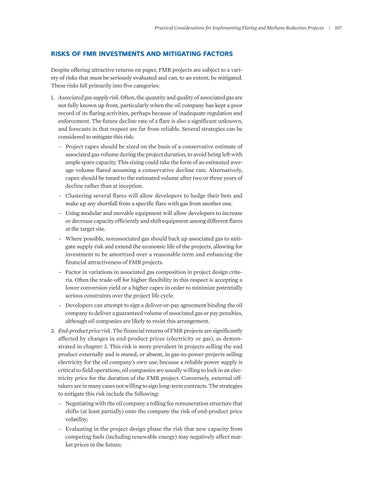Practical Considerations for Implementing Flaring and Methane Reduction Projects
RISKS OF FMR INVESTMENTS AND MITIGATING FACTORS Despite offering attractive returns on paper, FMR projects are subject to a variety of risks that must be seriously evaluated and can, to an extent, be mitigated. These risks fall primarily into five categories: 1. Associated gas supply risk. Often, the quantity and quality of associated gas are not fully known up front, particularly when the oil company has kept a poor record of its flaring activities, perhaps because of inadequate regulation and enforcement. The future decline rate of a flare is also a significant unknown, and forecasts in that respect are far from reliable. Several strategies can be considered to mitigate this risk: –– Project capex should be sized on the basis of a conservative estimate of associated gas volume during the project duration, to avoid being left with ample spare capacity. This sizing could take the form of an estimated average volume flared assuming a conservative decline rate. Alternatively, capex should be tuned to the estimated volume after two or three years of decline rather than at inception. –– Clustering several flares will allow developers to hedge their bets and make up any shortfall from a specific flare with gas from another one. –– Using modular and movable equipment will allow developers to increase or decrease capacity efficiently and shift equipment among different flares at the target site. –– Where possible, nonassociated gas should back up associated gas to mitigate supply risk and extend the economic life of the projects, allowing for investment to be amortized over a reasonable term and enhancing the financial attractiveness of FMR projects. –– Factor in variations in associated gas composition in project design criteria. Often the trade-off for higher flexibility in this respect is accepting a lower conversion yield or a higher capex in order to minimize potentially serious constraints over the project life cycle. –– Developers can attempt to sign a deliver-or-pay agreement binding the oil company to deliver a guaranteed volume of associated gas or pay penalties, although oil companies are likely to resist this arrangement. 2. End-product price risk. The financial returns of FMR projects are significantly affected by changes in end-product prices (electricity or gas), as demonstrated in chapter 3. This risk is more prevalent in projects selling the end product externally and is muted, or absent, in gas-to-power projects selling electricity for the oil company’s own use; because a reliable power supply is critical to field operations, oil companies are usually willing to lock in an electricity price for the duration of the FMR project. Conversely, external off- takers are in many cases not willing to sign long-term contracts. The strategies to mitigate this risk include the following: –– Negotiating with the oil company a tolling fee remuneration structure that shifts (at least partially) onto the company the risk of end-product price volatility; –– Evaluating in the project design phase the risk that new capacity from competing fuels (including renewable energy) may negatively affect market prices in the future;
|
107


